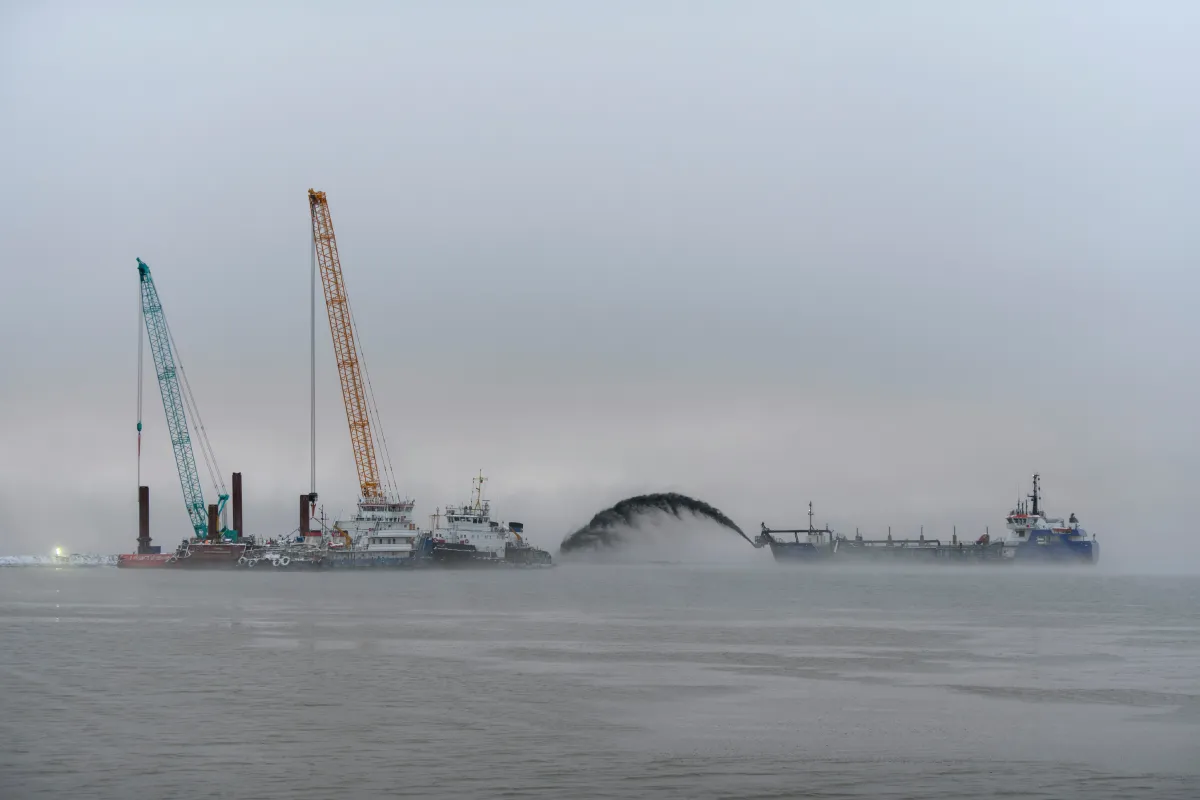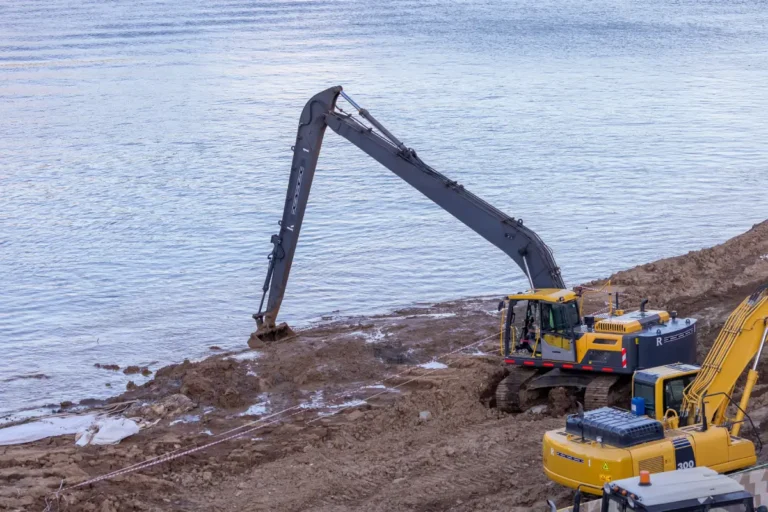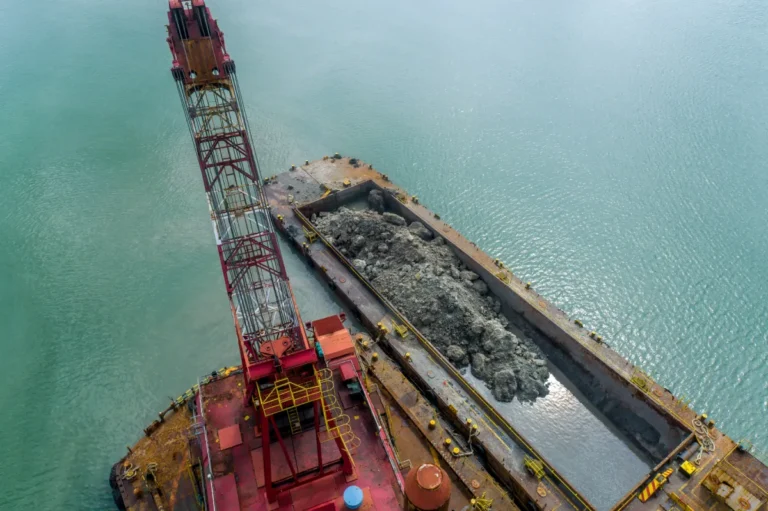Hopper dredging is one of the most versatile methods used to maintain and shape waterways, ports, and coastal regions. Over time, rivers and seas naturally move sediments, which causes channels to become shallow or silt to pile up where ships actually need clear routes. And it‘s obvious that without regular maintenance, ports can’t handle large vessels, because coastal defenses weaken with time, and even local ecosystems suffer from excess residue.
Hopper dredging becomes the saviour in this situation. Instead of depending on land-based machines or stationary dredgers, it uses highly mobile vessels known as trailing suction hopper dredgers (TSHDs). These ships are capable of sailing to the dredging site. They remove large amounts of material directly from the seabed, store it in an onboard hopper, and then transporting and release it at a designated location. This combination of dredging, transporting, and depositing makes them remarkably efficient for large-scale and ongoing marine projects.
In the following sections, we’ll take a closer look at how hopper dredging works, the technology behind it, the vessels involved, and the real-world applications that make it indispensable.
What Exactly is Hopper Dredging?
If we delve into the details, hopper dredging is a process where residue is removed from the seabed using a ship equipped with suction pipes and dragheads, and then stored in a large onboard tank called a hopper. Once the hopper is full, the vessel sails to a designated location to release the material, either for disposal or for beneficial reuse, such as land reclamation.
The ship that carries out this operation is known as a hopper dredger vessel, most often a trailing suction hopper dredge (TSHD). These ships are floating giants, ranging in capacity from 3,000 m³ to over 46,000 m³, depending on the project scale. Some of the largest in the world, like the Cristóbal Colón and Leiv Eiriksson, are capable of dredging at depths of 155 meters in the blue depths of the seabed; amazingly, they are almost as tall as a skyscraper.
This ability to dredge at depth, carry the load onboard, and travel long distances makes hopper dredging stand out from any other dredging method.
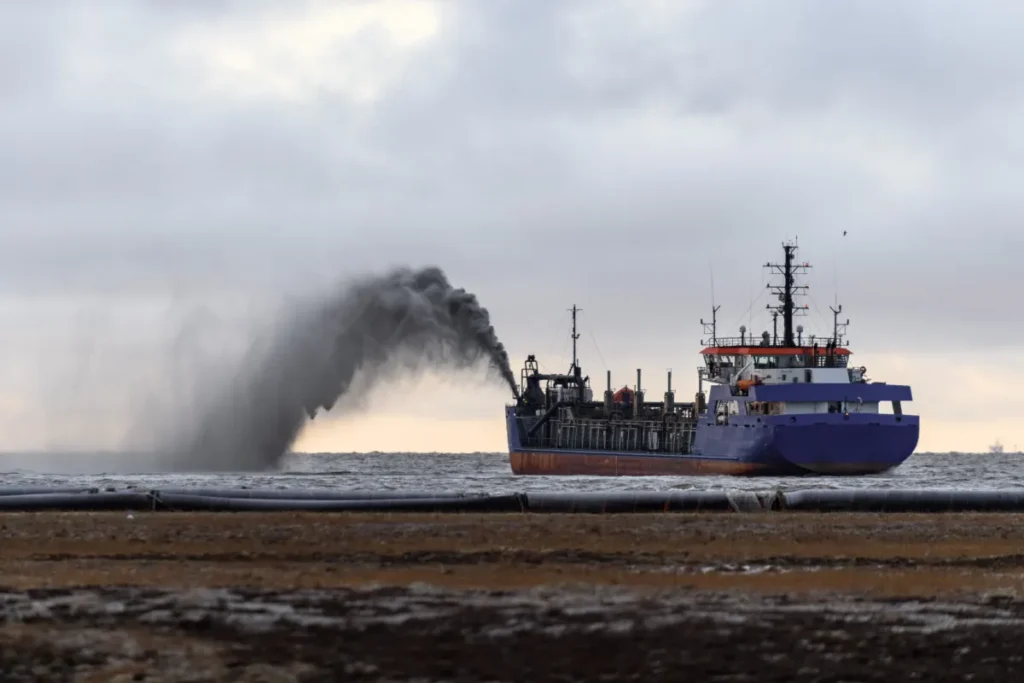
The Full Cycle of Hopper Dredging Operations
Dredging is not just about “scooping sand.” It’s a cycle of steps that requires engineering precision, an upgraded navigation system, and experienced crew members who are truly experts in their field. Let’s break down how a typical hopper dredging operation works:
Stage 1: Surveying and Planning
Every project kickstarts with hydrographic surveys. Advanced sonar and mapping tools create a 3D picture of the seabed. Engineers use this to figure out and pinpoint where residue has accumulated and how much needs removal.
Stage 2: Positioning the Hopper Dredger
The hopper dredger vessel moves into position precisely because of GPS, radar, and sometimes dynamic positioning systems. Their technology is top-notch and upgraded as per the changing times and requirements of the industry. Unlike stationary dredges, the trailing suction hopper dredge moves slowly across the target area while dredging.
Stage 3: Deploying the Drag Arms
Suction pipes called drag arms are lowered to the seabed. These arms, sometimes over 100 meters long, are fitted with dragheads which are designed to loosen compact sediments and capture them.
Stage 4: Suction and Collection
Powerful centrifugal dredge pumps suck up the loosened sediment-water mixture into the hopper. Here, the heavier particles settle, while excess water is expelled through overflow systems.
Stage 5: Transport to Disposal or Reclamation Site
Once the hopper is full, which can take anywhere from 30 minutes to several hours depending on material and hopper dredger vessel size, the dredger sails to the designated site. Unlike cutter suction dredgers that rely on stationary pipelines, hopper dredgers are self-contained and mobile.
Stage 6: Disposal or Beneficial Use
The dredged material can be:
- Released through the bottom doors into deep water.
- Pumped out via pipelines for land reclamation projects.
- Rainbowed onto beaches in an arcing spray of sand and water.
This cycle is repeated until the required dredging volume is achieved.
Techniques in Hopper Dredging
The techniques of dredging vary depending on project requirements, water depth, and the type of sediment being removed. Below are the most common methods:
1. Trailing Suction Hopper Dredging
This is the most widely used method. A trailing suction hopper dredge sails slowly along the seabed while dragheads loosen and suck up sediments. The material is stored in the onboard hopper.
2. Overflow Dredging
During suction, excess water is released from the hopper, allowing denser materials like sand and gravel to settle inside. This maximizes hopper capacity.
3. Bottom Discharge
Once full, the hopper dredger vessel opens its bottom doors to discharge sediment at the designated location. This is often used in offshore disposal sites.
4. Pump-Out Discharge
In this method, powerful pumps and hopper dredger vessels transfer dredged material via pipelines onto land for reclamation, dike construction, or beach nourishment.
5. Rainbowing Technique
Here, dredged material mixed with water is sprayed through a nozzle in an arc onto reclamation sites, much like a rainbow. This method is effective for beach nourishment or creating new land platforms.
Each technique offers its own advantages and features, which help hopper dredging to be adapted to different marine environments as per the requirements.
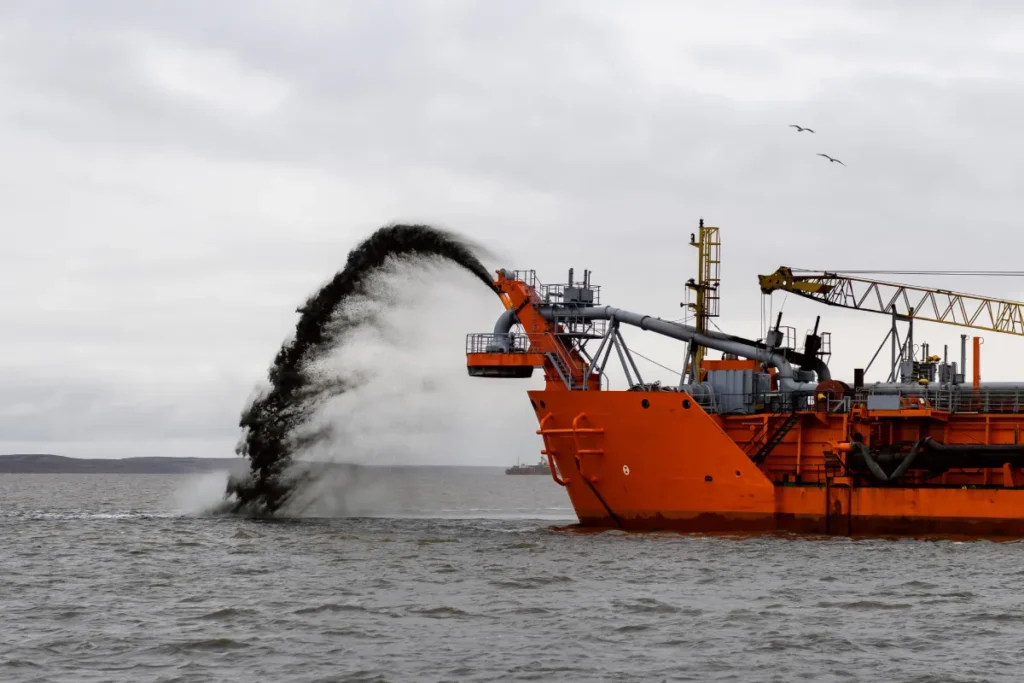
Equipment Used in Hopper Dredging
Hopper dredging relies on highly specialized equipment, much of it integrated into the hopper dredger vessel. Key components include:
1. Trailing Suction Pipes (Drag Arms)
Flexible pipes fitted with dragheads that extend to the seabed and suction up material.
2. Dragheads
These are located at the end of suction pipes, loosen compacted sediments while minimizing disturbance.
3. Dredge Pumps
High-capacity pumps create suction to lift material from the seabed into the hopper.
4. hopper dredger vessel
A massive onboard storage compartment where dredged material is collected and temporarily stored.
5. Overflow Systems
Allow excess water to escape, optimizing storage for solids.
6. Bottom Doors
Hydraulically operated doors at the base of the hopper enable quick discharge of material.
7. Pump-Out Systems and Nozzles
Used for pipeline transport or rainbowing discharge methods.
These components work together seamlessly to ensure the trailing suction hopper dredge operates effectively and safely in marine environments.
Advantages of Hopper Dredging
Hopper dredging has become one of the most preferred methods worldwide due to its versatility and efficiency. Key advantages include:
- Mobility: Hopper dredgers can dredge, transport, and discharge material without the need for additional barges or pipelines.
High Capacity: hopper dredger vessel can handle large volumes of sediment in one cycle. - Flexibility: Suitable for a wide range of sediments, from silt to coarse sand.
- Efficiency: It is highly Capable of working in harsh offshore environments and deep waters.
- Safety: On the seabed, no one has to risk their life and go underwater because there is less human involvement in hazardous underwater operations.
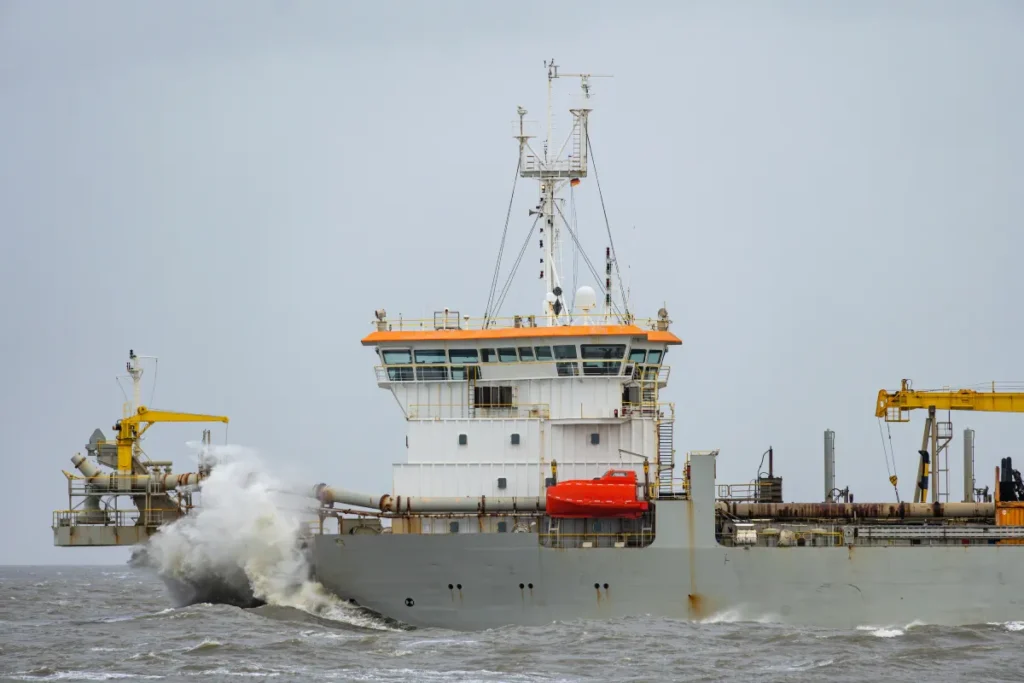
Where Hopper Dredging Makes the Biggest Impact
Hopper dredging is extremely important and affects nearly all aspects of maritime and coastal infrastructure.
Keeping Ports and Harbors Navigable
Residue naturally builds up in harbors, reducing water depth. Regular dredging ensures that large cargo vessels can dock safely. For instance, the Port of Rotterdam, Europe’s largest, relies heavily on trailing suction hopper dredges for ongoing maintenance.
Deepening Global Trade Routes
With container ships getting larger (the latest can carry 24,000 TEU), ports and access channels must be deepened. Hopper dredgers are often the mainstay of these large-scale capital dredging projects.
Land Reclamation and Urban Expansion
Cities like Singapore and Dubai are famous examples where hopper dredging has literally created new land. In Dubai, the Palm Jumeirah islands required around 94 million cubic meters of sand, much of it placed using rainbowing.
Beach Nourishment and Coastal Defense
As climate change accelerates erosion, hopper dredgers replenish beaches. In the U.S., for example, dredging is a key part of the Army Corps of Engineers’ coastal protection projects.
Offshore Energy and Infrastructure
Before offshore wind farms or oil platforms are installed, seabeds must be leveled. Hopper dredgers prepare these foundations, ensuring stability.
Environmental Cleanup
In polluted rivers or harbors, dredging removes contaminated residue, which in the end restores overall aquatic health.
Hopper Dredging and Sustainability
In modern times, sustainability plays a central role in dredging operations. Hopper dredging has evolved with advanced technologies to reduce environmental impact:
- Precision dredging guided by real-time monitoring minimizes over-dredging.
- Eco-friendly dragheads limit seabed disturbance.
- Sediment reuse supports land reclamation and coastal defense projects.
- Emission-reducing engines improve the fuel efficiency of hopper dredger vessels.
These measures make hopper dredging not only effective but also aligned with global sustainability goals.
Global Demand for Hopper Dredging
With the rise of sea trade, urbanization of coastal cities, and the implementation of climate adaptation strategies, hopper dredging continues to experience strong demand. According to industry reports, over 70% of international trade is carried by sea, making dredging crucial for port maintenance and expansion. Additionally, climate change-driven sea-level rise has accelerated the need for beach nourishment and coastal protection projects, where trailing suction hopper dredgers have a major role.
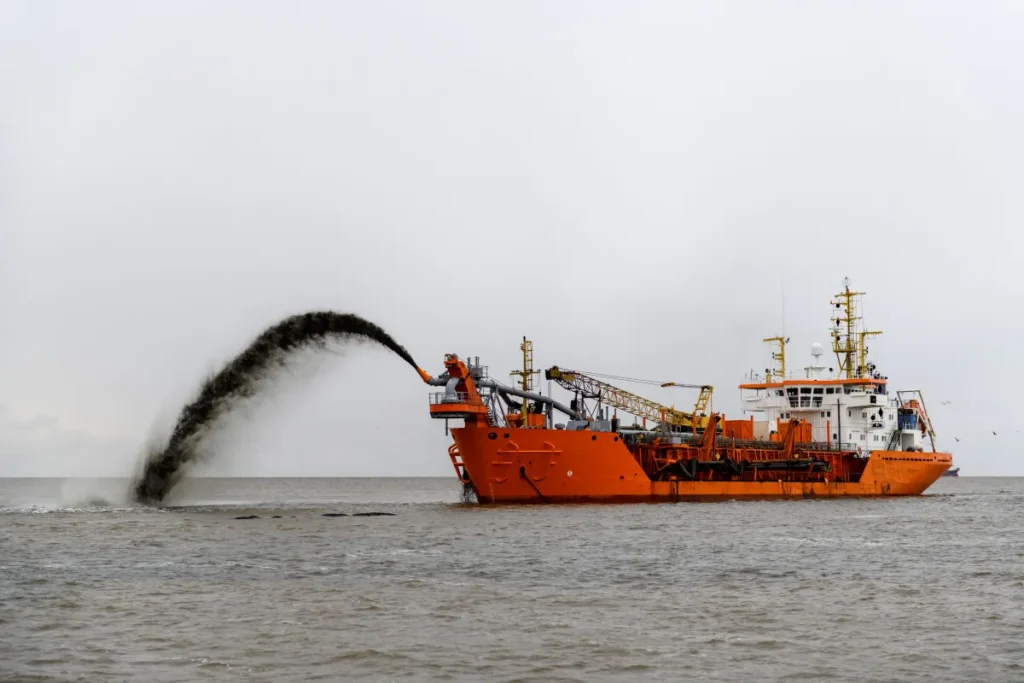
Times when Hopper Dredging has been in action
To make it concrete, here are two real-world examples:
1. Maasvlakte 2, Netherlands
As part of Rotterdam’s port expansion, more than 240 million cubic meters of sand were dredged and placed by hopper dredgers to create new land. This project is one of the largest reclamation efforts in Europe.
2. Palm Jumeirah, Dubai
Constructing the infamous palm-shaped island required precision hopper dredging and rainbowing. Trailing suction hopper dredges sprayed sand layer by layer to build the palm fronds, protected by a breakwater.
These examples highlight the remarkable role of dredging in shaping the history of coastlines.
Challenges and some limitations in Hopper Dredging
There’s not always a bed of roses; there are some challenges in hopper dredging, which are often encountered by leaders in the industry:
- Environmental Concerns: Sediment disposal can disturb ecosystems if it is not managed properly and left untouched for a long time.
- Operational Costs: Large hopper dredger vessels obviously require high fuel consumption, and regular maintenance and care. Plus, it also requires trained professionals. So it makes projects overall expensive.
- Weather Dependency: Offshore dredging is often limited by harsh weather conditions.
- Sediment Characteristics: Hard rock or consolidated clay may require alternative dredging methods.
Addressing these challenges is a tough and hectic job. But the solution is “innovative equipment” and stricter environmental regulations.
Making Hopper Dredging Sustainable
Sustainability has been a topic of discussion in various industries, and particularly in the maritime sector, it is evident that sustainability should be considered to maintain the entire process, becoming increasingly focused on dredging. Steps being taken include:
- Using low-emission engines and hybrid power systems.
- Developing eco-friendly dragheads that minimize seabed disturbance.
- Recycling dredged material for beach nourishment and construction.
- Using real-time monitoring to reduce environmental impact.
The shift towards green dredging reflects broader efforts in the maritime industry to align with global climate goals.
Future of Hopper Dredging
The future of dredging is marked by innovation, automation, and sustainability. Some trends include:
- Autonomous hopper dredger vessels for enhanced safety and efficiency.
- AI-driven dredging control systems that optimize draghead positioning.
- Hybrid and electric-powered dredgers to reduce carbon emissions.
- Data-driven operations that integrate hydrographic surveys and dredging performance in real time.
As the human populations grow and demand for adequate infrastructure remains a top requirement for governments, dredging will always be the main focus for maintaining global maritime logistics.
Shaping the Future of Our Shores
Hopper dredging may operate quietly beneath the waves, but its influence is visible everywhere, from the ports that keep global trade flowing to the reclaimed coastlines that enable cities to expand. With advanced trailing suction hopper dredges and high-capacity hopper dredger vessels, this method has become one of the most essential tools in maritime infrastructure. As shipping demands grow, coastal erosion intensifies, and climate adaptation becomes critical, hopper dredging will continue to play a pivotal role in shaping and safeguarding our marine environments.Looking ahead, advancements in automation, eco-friendly vessel technology, and precision dredging systems promise a future that is smarter, cleaner, and more sustainable. Whether you’re planning a new dredging project, preparing land for development, or reinforcing coastal defenses, partner with us at Washington Dredge Contractors. We bring decades of expertise, state-of-the-art equipment, and sustainable solutions to help you shape resilient coastlines and infrastructure that stand the test of time.


